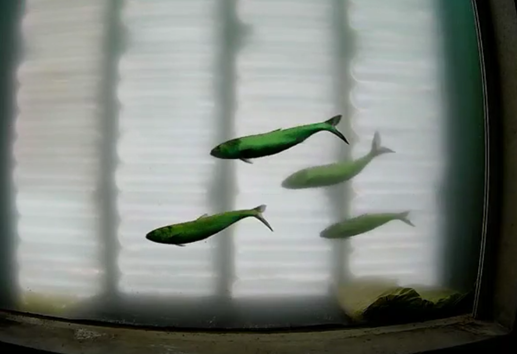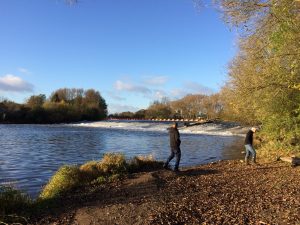
DNA evidence announced today by the Unlocking the Severn project has revealed that one of the UK’s rarest fish species has finally reached its ancient spawning habitat on the River Severn for the first time in nearly 180 years.
Unlocking the Severn is one of the biggest river restoration projects of its kind in Europe and this year completed a fourth and final fish pass, reconnecting 158 miles of the Severn’s habitat and restoring access to spawning grounds for the endangered twaite shad, as well as providing safer passage for a variety of migratory fish including salmon, eel and lamprey.
Now water samples containing shad DNA have proved that shad have successfully navigated all four new fish passes, providing hope for the recovery of a once renowned Severn species.
Charles Crundwell, Senior Technical Fisheries Specialist at the Environment Agency, comments: “The positive eDNA result is a huge milestone for our project. It is thrilling to know that the fish passes are working and shad are rediscovering key habitat lost to them for so long – 35 generations for these fish! Over the coming years, we look forward to seeing a growing proportion of the shad run spawning higher up the river, a recovery in the population and watching many more shad migrating past the Diglis fish window each May.”
A range of monitoring techniques was used to establish if shad had reached the spawning grounds. Cameras filming through a unique underwater window, fish fitted with tiny tags, environmental DNA analysis of water samples, and volunteer citizen scientists all played a part.
Lorna Pedersen from the Canal & River Trust explained: “In partnership with Bournemouth and Hull Universities, we used acoustic telemetry to monitor the shad. The fish are fitted with small tags that emit unique ultrasonic signals which are picked up by special acoustic receivers in the river. This year, from 100 tagged fish, shad were recorded travelling as far upstream as the final fish pass at Lincomb Weir. This proved shad were making use of the first three fish passes – great news for their first migration through new habitat – but did any venture further?
“Alongside the tagging programme, our volunteers took water samples for environmental DNA analysis – a cutting edge technique for biomonitoring rare and difficult to observe species. Samples taken in Stourport contained shad DNA, proving that shad had successfully navigated all four new fish passes and had the opportunity to explore the spawning habitats beyond for the first time in almost two centuries.”
Shad are a type of herring that migrate from the sea into freshwater every year to spawn. Historic records show that they once swam up the Severn in their hundreds of thousands on their annual migration each May. But when large navigation weirs were built in the 1840s, access to their spawning grounds in the upper reaches of the river was completely cut off. That is until now, after many years of planning and four years of complex construction, the completion of four massive fish passes has unlocked the UK’s longest river and reconnected habitat for a wide range of species.
A full report on the environmental DNA analysis of water samples is due to be published by Natural England later this year. Unlocking the Severn is delivered by Canal & River Trust via partnership with Severn Rivers Trust, Environment Agency and Natural England and is made possible with funding from the National Lottery Heritage Fund and the European Union LIFE programme. Details of the project can be found at https://www.unlockingthesevern.co.uk/.
Further notes to editors.
About Unlocking the Severn:
Unlocking the Severn is delivered by the Canal & River Trust, Severn Rivers Trust, Environment Agency, and Natural England. The project is one of the largest river connectivity projects of its kind ever attempted in Europe, with funding from the National Lottery – awarded through The National Lottery Heritage Fund – and the European Union LIFE programme.
Ultramodern fish passes have been completed on four navigation weirs on the River Severn, in time for fish migration on the UK’s longest river, with earlier fish passage improvements in 2019 at two sites on the River Teme.
Unlocking the Severn will also deliver ambitious heritage, education and science programmes that aim to reconnect local people with the river. This includes working with community groups along the river, thousands of school children, and creating opportunities for hundreds of volunteers.
The shad tagging programme was conducted in collaboration with scientists from Bournemouth University, University of Hull, and the Environment Agency.
www.unlockingthesevern.co.uk/ @SevernUnlocked
Shad migrating up the Severn meet the first of the new fish passes at Diglis in Worcester. A unique underwater window in this fish pass allows direct observation of migrating fish. This year 757 shad were recorded swimming through the pass by 25 June, an increase of 22% on 2021 (the first year the Diglis pass was operational).
Unlocking the Severn’s annual ‘shad run’ monitoring, further down the river in Tewkesbury, has shown that this is a critical time to help this endangered fish. Citizen science counts gave an estimate of only 1,541 shad migrating upstream at this location in 2022. These are the lowest numbers since the project’s monitoring began in 2017 and demonstrate a huge decline from the peak run rates which saw more than 14,000 shad at this location.
Shad are repeat spawners and can return to freshwater for up to five years to spawn. Monitoring scientists have also observed that the proportion of tagged fish returning to the river has also dropped dramatically. It is typical for over 55% of Severn shad to survive at sea and return to the river for spawning the next year. But this year only 32% of the fish tagged in 2021 returned. It is not known what extra challenges the shad faced out at sea this year. But one thing is certain; that fish who do make it onto the river need access to good spawning habitat, to give their offspring a better chance of survival, so that the population can recover again.


